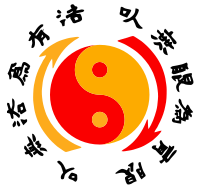Fractal Taijitus and the 'Way Of No Way' As the Heart's Desire
Recently I envisioned a new, more fractal version of the yin/yang symbol, also known as taijitu, wherein the smaller white circle appearing within the black yin, and the smaller black circle appearing within the white yang, are both themselves complete yin/yang symbols, which also contain the pair of smaller circles within them, that are likewise also complete yin/yang symbols, which also contain within them the two smaller circles which are also complete taijitus, and on, and on.
Here is a crude representation I created in GIMP, albeit only to the first order of a fractal pattern.

This image occurred to me as I was thinking of the saying, "there are exceptions to every rule".
If we treat that saying itself as a rule, then the exception to it must be that there is at least one rule that does not have any exceptions.
If there is at least one such rule, how do we know it isn't that one?
If it is, then the rule would contradict itself ... but also prove itself.
However, even if it isn't, and it is some other rule that has no exceptions, then it still seems to be proving itself by simultaneously disproving itself, in a never-ending sequence, making the proposition both true and false at the same time!
So by logic you can come to something that is in a sense wholly illogical yet is not 'wrong'. It just is.
For that matter, I imagine too that a certain rationality can spring from the irrational, in a similar way.
The physicist David Bohm once wrote of something he termed Wholeness and the Implicate Order. In it, he posited a theory whereby at some level, our physical reality manifests through a process of unfolding outwardly and enfolding back into itself, in a continual interplay.
Bohm was a close friend of Jiddu Krishnamurti, an enlightened teacher who held that Truth Is A Pathless Land. In turn, Bruce Lee, the famous martial artist, was known to have read Krishnamurti, having cited him as a profound influence. Bruce Lee himself is known for, among many other things, developing his own style of fighting called Jeet Kune Do.
The graphic emblem which Lee devised to represent Jeet Kune Do consists of a taijitu, around which appear Chinese characters which read: "Using no way as way" and "Having no limitation as limitation".

How can a statement simultaneously prove and disprove itself, being both true and false at the same time? How can there be a way of no way? How can someone be limited by having no limitations?
According to Lee, "There are no limits. There are only plateaus, and you must not stay there, you must go beyond them."
It seems to me that as humans we have access to infinite potential, yet we are also self-limiting beings. Who decides what or where your limitations are? What is the determining factor? Is it something you decide for yourself, or does the world, does the environment, and your conditioning, decide that for you? Or, is it a combination of the two, acting in complement, like the yin and the yang, one continually unfolding out and enfolding back into the other, striving to maintain harmony while still moving forward (or backward) toward some greater (or lesser) destiny.
As for myself, I have long tried to follow my heart, and my intuition, or as Thoreau might have said, my genius, wherever it led, even though I know not from where it comes. Moreover, I have seen that the ego's demands to capture that genius in order to forever fix it's frame of reference, somehow interrupts the flow. Such structuring of the free flow of energy into a fixed form, as knowledge, is part of the brain's function, whereby it constructs for itself a 'way'.
Having no way, one is lost. Therefore, having some particular way as a fixed path, is far superior to no way. Yet it is the way of no way which is superior still, to that of any particular way or fixed path. It need not be defined by the past.
Perhaps an analogy will help to illustrate. Imagine yourself attempting to do a flip or some more complicated aerial acrobatic. If you overthink it, attempting to guide yourself through the movement with your conscious mind in order to control the result, such thought may interfere with effortless action, so that you are more likely to perform the movement poorly, perhaps mechanically, with a stiffness. To perform the movement fluidly, with grace, there is a part of the mind that must consciously let go. The rational mind, which forever clings to the way of the known, while necessary, and fundamental to a certain domain of living in one respect, in another respect may present it's own limitation, as an obstacle to achieving some greater potential that is more closely bound to the heart. In ancient times it was the heart that was presumed to be the true seat of intelligence. Perhaps there is something to it after all.
Deeeepppp. The two-face from BatMan vibage